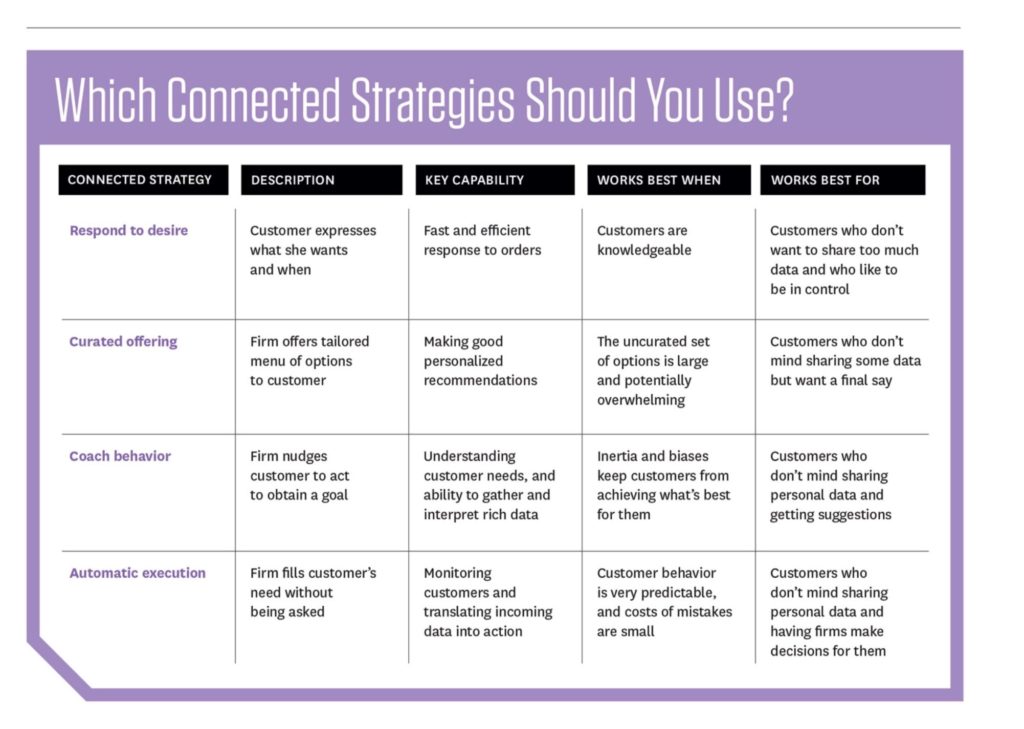As internet and mobile technologies continue to coalesce and changes in customer service delivery facilitate digital interactions underpinned by low friction methods of connectivity; enterprises today are building stronger and deeper ties with their customers than ever before. Companies used to engage episodically with customers in the past through reactive engagements and this was the nexus of the customer service value model. Today, its now possible to sense and mobilise offerings before customers are even aware of the need whilst concurrently boosting operating efficiencies and innovation through the capitalisation of what is coined ‘connected strategies.
Here, a tapestry of tools on the internet coupled with the emergence of data sharing, opt in engagement marketing, customer co-creation and disruptive product development fuels the new paradigm that can be summarised as a flow of responding to desire, creating a curated offering, coaching specific behaviours and automatic execution.
As professor Siggelkow and professor Terweisch describe in their Harvard Business Review article; “whats innovative here is not the technologies these strategies incorporate but the ways that companies deploy those technologies to develop continuous relationship with customers”.
HBR Article May-June 19: The Age Of Continuous Connection
By integrating these into the firms ecosystem we are able to generate value which feeds itself back through an iterative cycle into service and product development, ultimately enabling companies to achieve value chain evolution.
It’s worth looking into empirical examples and where connected strategies are being used already and how it integrates with existing processes and systems in marketing, business development and customer service. For example. Engagement marketing, for starters, is essentially rooted on the principal that the firm nurtures niched, segmented or mass communities of users and followers whilst targeting them with contextually relevant augmented products. Nike for example does this through its connected running shoes (via its wellness system) and pairs up stats and reminders via its app to ensure that close intimate association with runner. This in turn creates a compound effect by allowing Nike to transform itself from a maker of athletic gear into a purveyor of health, fitness and coaching services.
In terms of customer co-creation; the uptake of connected strategies has also facilitated customer co-creation. Taking the below excerpt and considering the MagicBands that Disney World issues to all its guests; these “incorporate radio frequency identification technology, allowing visitors to enter the park, get priority access to rides, pay for food and merchandise and unlock their hotel rooms”. The bands also help Disney locate guests anywhere in the park and then create customised experiences for them. Disney characters (played by actors) can personally greet guests passing by first names or even identify short lines and specific rides and influence efficient crowd herding at the theme parks. Additionally, the co-creation exists where cameras on the various rides can automatically take photographs of guests which Disney can use to create personalised memory books for them without ever having to pose for a picture – truly encapsulating a natural customer experience that creates memories and one which is all possible through the employment of connected strategies.
When it comes to product development; it’s important for the enterprise to anticipate customer wants and create as less friction between the logistics and product fulfilment cycle as possible. This can take many forms such as working through curated offerings wherein companies get actively involved in helping customers at an early stage of the customers journey: after the customers have figured out what they need but before they’ve decided how to fill that need. This strategy is one that needs to be executed property as this not only delights customers but generates efficiency benefits for companies, by steering customers towards products and services that firms can easily provide at the time. Personalised recommendation systems and architectures are key here and will be extremely useful for customers who value advice (but still want to make the final decision). Zoho SalesIQ for example, a CRM integrated chat system, allows you to set triggers that go off contextual information such landing page URL, time spent on site, actions performed (with custom javascript events taggable), operating system, location and existing CRM status. These enable personalised recommendation in the operating context and gives you a competitive edge by nudging consumers to make contact even when they don’t think they need it. Here, we are priming consumers for example by triggering “Can I take your enquiry please as we have a great special on at the moment” for a holiday packaging website as they would have arrived with the intent there in the first place; but required some coaching and nudging to step into the engagement and service fulfilment journey.
Ultimately, companies of all sizes need to employ connected strategies to not only remain competitive but effectively develop and nurture consumers into the consumption contexts. I have previously said that circumstances of rapid technological change and volatility of products and markets makes it palpable that no one best solution will prevail hence Its clear that success depends on evolving and learning by mutual monitoring and this is the nexus of these strategies. The firm needs to constantly reinvent itself and strive for emergent order whilst fostering a culture of openness, sharing and risk taking. This will lead to not only growth but the further amplification of consumer sovereignty by enabling services and products to evolve on consultation of actual data, trends, behaviours and outcomes. For a simple and transplantable matrix of connected strategies for inspiration, please refer to the below table courtesy of HBR.

The Age Of Continuous Connection: Harvard Business Review Article |
Citation: HBR May-June 2019; Prof Nicolag Siggelkow & Prof Christian Terwiesch


